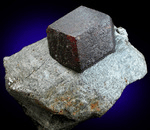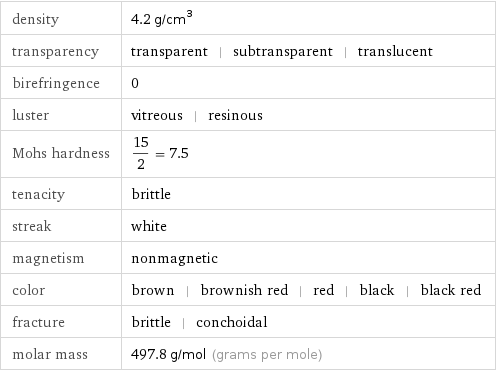Input interpretation

almandine (mineral)
Image

Image
General properties

alternate names | adelaide-rubin | adelaide ruby | alabandine ruby | alamandine | almandine garnet | almandite | oriental garnet formula | Fe^(2+)_3Al_2(SiO_4)_3
Basic properties

density | 4.2 g/cm^3 transparency | transparent | subtransparent | translucent birefringence | 0 luster | vitreous | resinous Mohs hardness | 15/2 = 7.5 tenacity | brittle streak | white magnetism | nonmagnetic color | brown | brownish red | red | black | black red fracture | brittle | conchoidal molar mass | 497.8 g/mol (grams per mole)
Units

Mineral identifiers

Strunz ID | VIII/A.08-20 Dana ID | 51.4.3a.2
Crystallographic properties

crystal system | cubic crystal class | 4/m-32/m unit cell volume | 1531 Å^3 (cubic ångströms) d-spacing | 2.569 Å (ångströms) | 1.54 Å (ångströms) | 2.873 Å (ångströms) intensity | 100% | 50% | 40% molecules per unit cell | 8 molecules per cell refractive indices | 0 | 0 | 0 | 0 | 0 | 1.83 dispersion | weak unit cell lengths | 11.53 Å (ångströms) | 11.53 Å (ångströms) | 11.53 Å (ångströms) unit cell angles | 90° (degrees) | 90° (degrees) | 90° (degrees)
Wikipedia summary

Almandine, also known as almandite, is a species of mineral belonging to the garnet group. The name is a corruption of alabandicus, which is the name applied by Pliny the Elder to a stone found or worked at Alabanda, a town in Caria in Asia Minor. Almandine is an iron alumina garnet, of deep red color, inclining to purple. It is frequently cut with a convex face, or en cabochon, and is then known as carbuncle. Viewed through the spectroscope in a strong light, it generally shows three characteristic absorption bands.